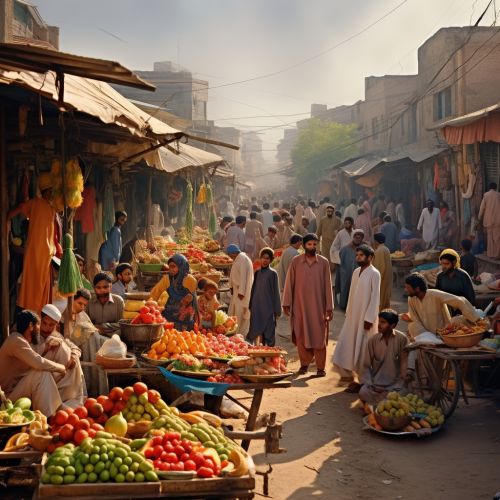Economy of Pakistan
Overview
The economy is a mixed economy, with sectors ranging from textiles, agriculture, healthcare, and IT services. It is the 23rd largest in the world in terms of purchasing power parity (PPP), and the 42nd largest in terms of nominal gross domestic product. Pakistan has a population of over 220 million (the world's 5th-largest), giving it a nominal GDP per capita of $1,357 in 2019, which ranks 154th in the world for 2019. However, Pakistan's undocumented economy is estimated to be 36% of its overall economy, which is not taken into consideration when calculating per capita income. Pakistan is a developing country and is one of the Next Eleven, a group of eleven countries that, along with the BRICs, have a high potential to become the world's largest economies in the 21st century.


History
The economic history of Pakistan since independence has been characterized by periods of economic growth and bust. The economy was relatively prosperous during the first two decades, but suffered from internal political disputes, a fast-growing population, mixed levels of foreign investment, and a costly, ongoing conflict with neighbouring India. In 2005, the World Bank named Pakistan the top reformer in its area and among the top 20 reformers globally.
Sectors
Agriculture
Agriculture accounts for about 18.9% of Pakistan's GDP and employs about 42.3% of the labour force. The most important crops are wheat, sugarcane, cotton, and rice, which together account for more than 75% of the value of total crop output. Despite improvements in the agricultural sector, outdated irrigation practices and an ongoing dispute with India over water rights pose challenges.
Industry
The industrial sector makes up approximately 20.3% of the GDP. Major industries include textiles, food processing, pharmaceuticals, construction materials, shrimp, fertilizer, steel, and car manufacturing.
Services
The services sector accounts for about 60.2% of GDP. Tourism is a growing industry in Pakistan, with more than 1.9 million foreign tourists visiting in 2019 compared to 563,000 in 2014. Other major industries in the services sector include IT services, telecommunications, and banking.
Trade and investment
Pakistan's main export partners are the US, China, the UK, and Germany while its main import partners are China, the UAE, and the US. Pakistan is a member of several international organizations, including the World Trade Organization (WTO), the South Asian Free Trade Area (SAFTA), and the China-Pakistan Economic Corridor (CPEC).
Challenges
Despite these strengths, the Pakistani economy faces numerous challenges, including political instability, corruption, lack of infrastructure, and a large informal economy that is not subject to taxation. In addition, the country faces significant challenges in education, healthcare, and public debt.
Future prospects
The future of Pakistan's economy depends on various factors, including political stability, economic reform, access to capital, and the country's ability to attract foreign investment. The China-Pakistan Economic Corridor (CPEC) is expected to play a major role in the economic future of Pakistan.
